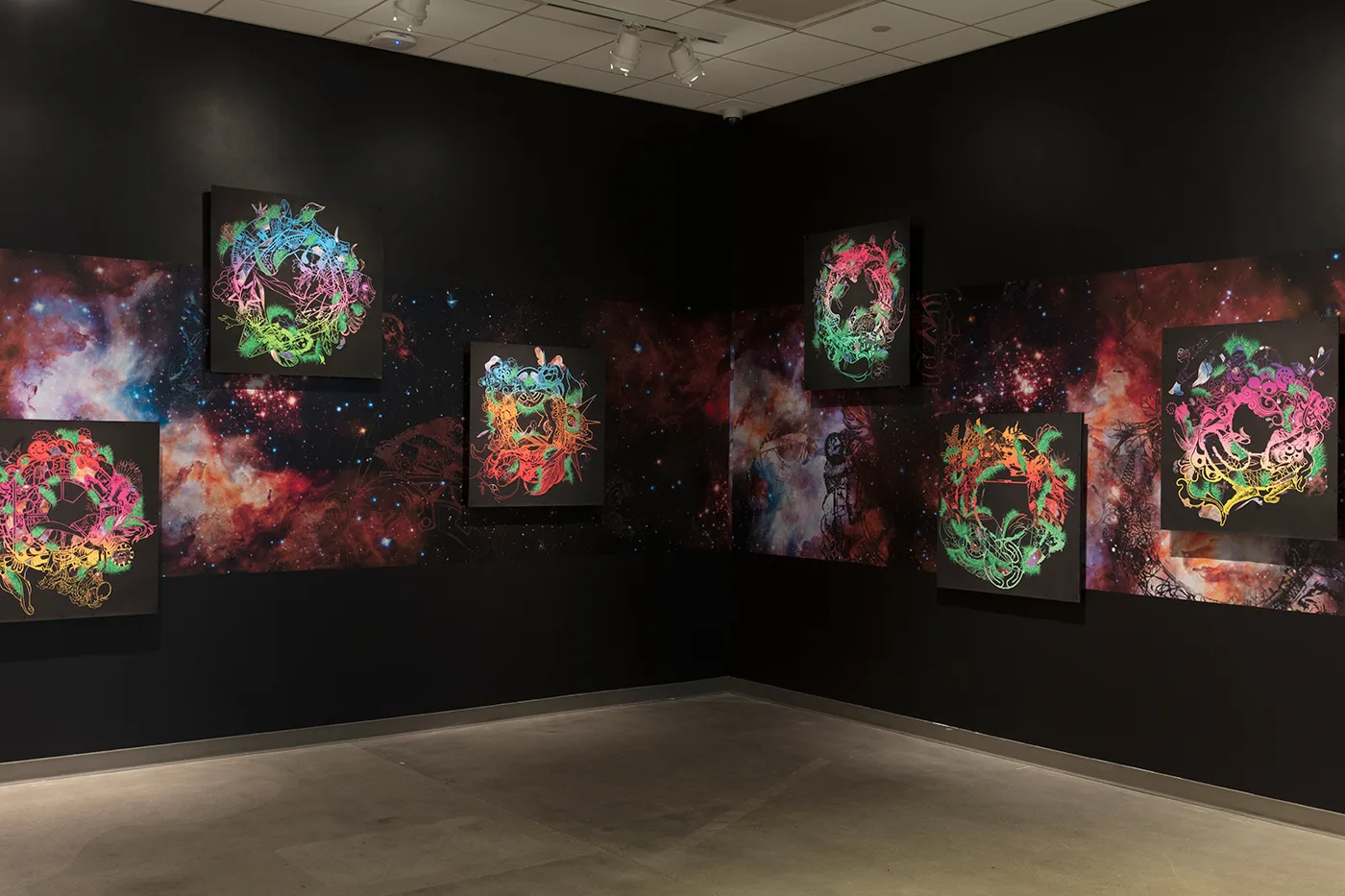
Transcending Time and Space Combines Eclectic Imagery to Bring Awareness to Indigenous Issues
Art
Portals are a popular concept in science fiction, allowing visitors to transcend time, space and place. The UMFA’s newest exhibition, Transcending Time and Space, mixes ideas, philosophies, mediums and concepts together to create a series of “portals” that merge science fiction with indigenous cultural and spiritual traditions, all with the intention of raising awareness regarding indigenous social issues and elevating personal consciousness in the viewer.
The exhibit, which is hosted in the UMFA’s Acme Lab, is a collaboration between David Rios Ferreira, a visual artist, independent curator and museum professional, and Denae Shanidiin, a Utah-based artist of Diné and Korean heritage and an activist with Restoring Ancestral Winds.
The exhibit features a range of eclectic mediums (abstracted drawings, collages, photographs and video) and a variety of visuals (popular science fiction imagery, historical photographs, indigenous artwork, elements of nature and neon lines and concentric circles). The exhibit’s overarching theme concerns imagined portals and gateways that transport the visitor to another “plane” through the intersection of the sci-fi with the spiritual. Each piece has layers of meaning, guiding the viewer into a portal in which they are forced to examine their place in the historical human experience and think about the many injustices present in the world today.

“The exhibit’s overarching theme concerns imagined portals and gateways that transport the visitor to another “plane” through the intersection of the sci-fi with the spiritual.”
Ferreira was moved in part by the ever-growing tragedy of missing and murdered Indigenous people—something he explores in collaboration with Shanidiin as the exhibit combines community art-making, imagined time travel and spirituality as a vehicle for thinking about love, loss and memory. The exhibit features several distinct areas, demonstrating the diversity of portals and the many ways to connect with others across distance and loss (of all kinds)—a timelier theme than ever these day.
Ferreira’s brightly colored Gateway series greets the visitor upon entry. The six pieces (c-print, collage and gouache on polypropylene) feature gradients of bright neon colors in concentric circles and lines of varying thicknesses, subtly interspersed with telescope-quality imagery of outer space and wreath-like greenery. The lines take the form of popular culture science fiction artifacts, including the millennium falcon. To create his portals, Ferreira deconstructs his source imagery, reforming and repurposing it into what he calls “temporal beings” in which past and present coexist, using popular imagery to be “relevant to that space and community” with a “specific aesthetic that speaks to that place and people.” Additionally, Shanidiin emphasizes that “the core of Indigeneity is to be cosmically and earthly bonded to relationships.”
Ferreira continues merging historical images with Indigenous symbology and pop culture in the piece, Did you see me? Did you hear me? Did you hear her? Did you hear us? Did you find me? (marker, gouache and collage on mylar), a dense and abstract hybrid work. The piece was created to bring awareness to many contemporary First Nation’s issues, including Missing and Murdered Indigenous People. Ferreira notes that he uses abstract images to represent the lives of missing people by “bringing realism to abstract social issues.”

“[Transcending Time and Space] demonstrat[es] the diversity of portals and the many ways to connect with others across distance and loss (of all kinds)—a timelier theme than ever these day.”
A series of four photographs, Ha’aa’aah (East), Shádi’ááh (South), E’e’aah (West), “Náhookös (North) and videos guide visitors through “community-made gateways,” or “unportraits,” that express the love, loss and memory of people in the indigenous community.
Finally, the large, three-dimensional Messages through Time and Space features a black void of velvet, mimicking a portal that invites visitors to contemplate “those they might’ve lost, those they miss across distances, and even those they have yet to meet” by writing a message on a piece of black paper and tossing it into the “void.”
Each portal in the exhibit is its own unique work of art, drawing visitors into not just the pieces, but their own inner psyches and experiences and encouraging them to reflect on their place in time and space and the human experience as a whole. Transcending Time and Space will be on display at the UMFA through December 4, 2022. The museum is open Wed. from 10 a.m.–8 p.m. and Thur.–Sat. From 10 a.m.–5 p.m. Tickets may be reserved in advance at UMFA.utah.edu/visit.
Read about past UMFA exhibits here:
A Space in Time: Space Maker Reflects the Ties Between Place and Identity
Using Storytelling to Protect Salt Lake Valley’s Waterways: The Confluence Exhibit at UMFA